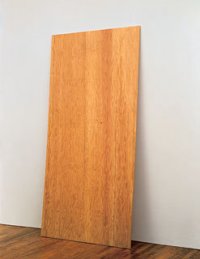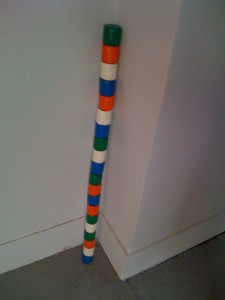Lean at Nicole Klagsbrun.
In the end Bas Jan Ader is most remembered for disappearing. Before that it was falling. Off a roof or into a canal, from Los Angeles to London to Amsterdam he would fall. It all had a Buster Keaton hapless, sad sack quality to it. And indeed one of my favorite of his video pieces is ‘I’m too sad to tell you’ (1971, see below) where the emotion that underscored all those not-suicide attempts is lampooned or perhaps not. In Lean, the current group show at Nicole Klagsbrun, he is teamed up with the also lost, to cancer at a way too early age, Andre Cadere. Cadere’s absence is all the more poignant given the presence of one of his poles. As if he had carefully placed it there –as was his way with the poles in his lifetime– and was strolling through the gallery next door. He’ll be back later to pick up the pole, won’t he? Alas not.
http://www.youtube.com/watch?v=vUzBCl6iVoc
Not to automatically diminish the work of anyone else in this smart show, but the credentials of having been there and of having invented the wheel in the 1970’s shine very, very brightly. Not everyone is lost in the glare. Robert Gober is here too. No slouch he, he stumps us (well me) with a glibly authentic looking sheet of plywood. It is an old piece, 1987, that I had heard about but never seen before. Gober’s plywood is, as is his way, a hand made replica of that industrially produced dronewood that is distributed by the thousand-truck load each day across the nation. The hand made board leans against the gallery wall staking out a territory between artisanal virtuosity and Home Depot delivery. Gober’s work has several registers. Here there is none of the fascination with surrealist devices and comic sexuality, none of the dioramas that allude to narrative heft. Plywood –that’s the title– is Gober’s blank verse mode. As such one is astonished that plywood can be so un-prosaic and thus so uncanny, indeed that the emotional stakes can be so high. The 4×8 foot board (slightly off size because it is hand made) moonlights as the metaphysician, pondering its own banal, mournful existence. Gober has struggled often with the rites of mourning. In truth it has never been far from his musings. Whether it be the mournful survivors of Catholicism or prison, or the mournful politics of his work during the AIDS crisis of the 1980’s and early 1990’s, which is exactly the period Plywood dates from. Oblique though it is, mourning of some inevitably imprecise quality is in the tone of Plywood.
gallery wall staking out a territory between artisanal virtuosity and Home Depot delivery. Gober’s work has several registers. Here there is none of the fascination with surrealist devices and comic sexuality, none of the dioramas that allude to narrative heft. Plywood –that’s the title– is Gober’s blank verse mode. As such one is astonished that plywood can be so un-prosaic and thus so uncanny, indeed that the emotional stakes can be so high. The 4×8 foot board (slightly off size because it is hand made) moonlights as the metaphysician, pondering its own banal, mournful existence. Gober has struggled often with the rites of mourning. In truth it has never been far from his musings. Whether it be the mournful survivors of Catholicism or prison, or the mournful politics of his work during the AIDS crisis of the 1980’s and early 1990’s, which is exactly the period Plywood dates from. Oblique though it is, mourning of some inevitably imprecise quality is in the tone of Plywood.
(Meanwhile a much more easily seductive piece of Gober’s, a paean to mourning’s sibling, longing –a single red shoe, probable provenance, Dorothy– is in another smart group show at Anna Kustera)
John McCracken’s leaning slab (UFO 2002) is also made of plywood, though you’d never know it. McCracken as usual works up the super-duper, resilient, gleaning surface of his resined slab. The piece reflects back a softened version of the works behind the viewer. When I was there Mary Heilman’s Sculpture of Night shimmered in and out of reflected view, on McCracken shiny surface, spinning formal riffs of color and shape. If Gober’s Plywood will not sit still and be a bland minimalist object, inversely McCracken’s sheened plywood will valiantly pretend to be a minimalist sculpture. And yet McCracken has long mused upon the esoteric, the extra terrestrial and the metaphysical as they pertain to his work. In a 1997 interview with Dike Blair he offered, “I’m after a physical object that appears to be nonphysical, hallucinatory or holographic. Otherworldly, in other words”. It is an ambiguous territory to hike. The nonspecificity of the ‘otherworldly’ I mean. More accurately perhaps we could think of it as the not-this-worldly. Heilman’s aforementioned Sculpture of Night does the trick to some extent, calling through its dark rayon flock coating toward a perch in the nightscape of a dream world. She even provides the perch come shelf atop the leaning rickety, stick support. And once there one dreams of what? Well other worlds might be McCracken’s answer. That this Occultist tendency shades his project needs to be repeated –mantra like– in order to maintain a distance between his work and the gravitational lure of minimalism. Or perhaps if one does not intone the mantra the minimalist orbit itself goes out of whack, which just could be the most important aspect of a body of work that quacks like a duck but is really out to cook the goose.
Richard Tuttle has a chunk of painted Styrofoam leaning against his piece of wall. Maybe two feet high, if it evokes anything it is a junked piece of an automobile. The work restates a title Tuttle has frequented over the years, Source of Imagery, 11, no.12. More blatantly than his peers in the show Tuttle reminds us of the lack of –or at least the elusiveness of– images, of grounding map points or clarion references in much art practice. Like some other artists in the show Tuttle stretches out to grab at the fleeting. He pulls back, as he has been doing for decades now, scraps of bric a brac that twisted, turned or tied may open onto a source of imagery. And as casual as Tuttle’s relation to an image is, so too in Lean, is the relation of all the work to the gallery space. What might it mean to just prop your art up somewhere rather than ‘install’ it, to brag about your ran-out-of-nails aesthetic that pushes showing itself into the foreground? Does it shift some order of dependence? Well I’m not sure about that. But it does foreground the mode of address in a way that most static, gallery bound art does not. Because this mostly flat art work leans, the focal point is shifted from the picture plane to the relation between work and the gesture of showing the work. This, in turn, takes us one step back from conventional conditions of aesthetic pleasure.
Leaning was very important for Freud. That the erotic impulses should lean upon bodily needs was his epiphany. Nourishment + pleasure for the infant at the breast was his moment of recognition. That erotic pleasure goes, thus, from being a side effect of functional need to being a drive in itself was his conclusion. And that aesthetics is merely –if that is the word– the sublimation of the erotic was his pronouncement.
The work in the show leans heavily upon this probably odd calculus of pleasure. The pleasures of shiny surfaces imbued with the allure of concocted utopian other worlds; the pleasures of metaphysical solutions to mournful yearnings; the pleasures of recycling the trash into cultural gee gaws. Or, with Jan Ader, the mirthful pleasures of telling everyone what they maybe did not want to hear, “I’m gong down!” (See videotape above). “I’m actually going to fall over.” (See videotape below).
http://www.youtube.com/watch?v=EiWyrEyLY8Y
And so it seems to all beg the question, if you lean too much, lean too far, what happens? Well, duh, you fall over. Jan Ader knew this. He literalized it to darkly comic effect. Andre Cadere knew it too in a slightly skewed way; he knew (well I’d like to think he wanted to toy with knowing) that you can take it with you when you go. It was the fact that you have to go (that there is nothing worth staying for?) that perhaps shaped his pole accompanied derive through Europe and North America.
I saw him once. In London, ambling down Gower Street near the University College buildings. Some art-event had just occurred. He had probably been at it. I saw him walk with a pole into a pub, the same pub where everyone headed post ‘event’. He leant the pole against the bar while he took a drink. It was way too crowded to really see more than that. (And way too long ago to remember vividly). But I like to imagine him later strolling off with his pole, slightly inebriated and leaning into his drunkenness. And maybe this is where Freud missed the point: inebriated leaning, drunkenness, short-circuits the need for sublimation. One of the strengths of the show at Klagsbrun is the sense of drunken artworks using the gallery cube to stop them from falling flat on their face.
Nicole Klagsbrun Gallery
526 WEST 26TH STREET NO. 213
NEW YORK, NY 10001
T. 212.243.3335 F.212.243.1059







Dorothy by way of the Village:
– Robert Gober, Robert Gober Sculptures and Installations, 1979-2007, p.264